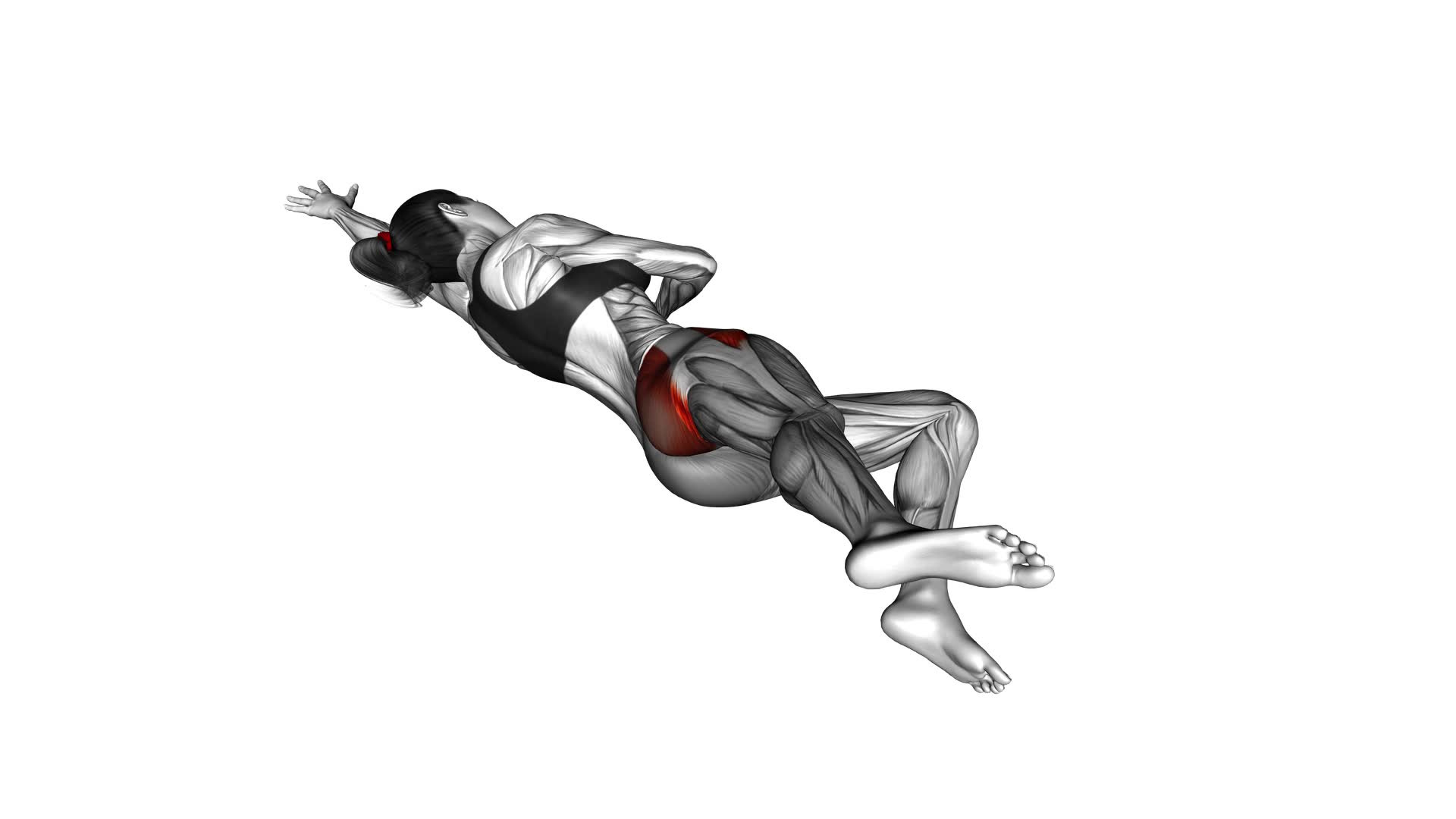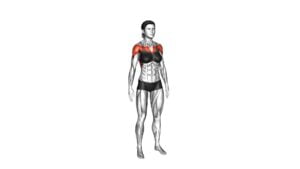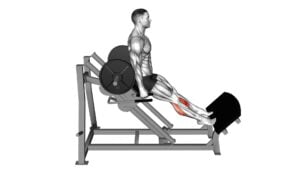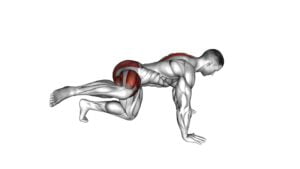Side Lying Diagonal Backward Leg Raise (female) – Video Exercise Guide & Tips

Get ready to tone and strengthen your legs with the side lying diagonal backward leg raise! In this video exercise guide, we'll show you how to perform this move with proper form and technique, along with modifications and progressions to challenge yourself.
Watch This Exercise Video
Avoid common mistakes and get the most out of your workout with our helpful tips.
So grab a mat and let's get started on achieving those strong, lean legs!
Key Takeaways
- Side Lying Diagonal Backward Leg Raise is an effective warm-up exercise that increases blood flow to targeted muscles.
- Proper form and technique are important for preventing injuries and maximizing muscle engagement.
- The exercise can be modified and progressed by adding resistance, such as ankle weights or resistance bands.
- Beginners can start with simplified variations and gradually build strength and confidence before advancing to more challenging modifications.
Benefits of Side Lying Diagonal Backward Leg Raise
To maximize the effectiveness of your workout, incorporate the benefits of side lying diagonal backward leg raises. These exercises aren't only a great way to target your glutes and hamstrings but also provide several other benefits for your overall fitness.
Firstly, warm-up exercises are necessary before engaging in any intense workout routine. Side lying diagonal backward leg raises are an excellent warm-up exercise as they activate your muscles and prepare your body for more challenging movements. By performing these leg raises, you can increase blood flow to the targeted muscles, ensuring they're ready for the main part of your workout.
Additionally, rest and recovery are essential components of any effective fitness regimen. Side lying diagonal backward leg raises can be a great exercise to include during your active recovery days. These leg raises provide a low-impact yet effective way to engage your muscles without putting excessive strain on your joints. By incorporating these exercises into your rest days, you can promote muscle recovery and prevent overtraining.
Equipment Needed for the Exercise
For this exercise, you'll need a mat or soft surface to lie on. This will provide comfort and support throughout the movement. It's important to have a cushioned surface to protect your body and prevent any unnecessary strain or discomfort.
In addition to the mat, it's recommended to perform warm-up exercises prior to starting the side lying diagonal backward leg raise. Warming up helps to prepare your body for the exercise and reduces the risk of injury. Simple warm-up exercises such as leg swings, hip circles, and gentle stretches can be beneficial.
After completing the exercise, it's crucial to allow your body time for rest and recovery. Resting allows your muscles to repair and rebuild, which is essential for muscle growth and overall fitness. Taking rest days in between workouts is highly recommended to prevent overtraining and give your body adequate time to recover.
Proper Form and Technique
Begin the side lying diagonal backward leg raise exercise by positioning yourself on a mat or soft surface. Proper form and technique are crucial for maximizing the benefits of this exercise and preventing injury. Here are some key points to keep in mind:
- Engage your core: Before starting the leg raise, activate your core muscles by drawing your belly button towards your spine. This will help stabilize your body and protect your lower back.
- Maintain proper alignment: Keep your body in a straight line from your head to your heels throughout the exercise. Avoid sagging or arching your back, as this can strain your spine.
- Control your movements: Lift your leg slowly and with control, focusing on using the muscles of your glutes and hamstrings. Avoid swinging your leg or using momentum to lift it, as this reduces the effectiveness of the exercise.
- Don't forget to breathe: Inhale as you lower your leg and exhale as you lift it. Proper breathing helps oxygenate your muscles and improves your overall performance.
Remember, warming up before any exercise is essential to prepare your body for movement and reduce the risk of injury. Additionally, make sure to allow yourself proper rest and recovery between workouts to promote muscle growth and prevent overuse injuries.
Incorporating these tips into your side lying diagonal backward leg raise routine will help you achieve optimal results while keeping your body safe.
Modifications and Progressions
Now let's talk about some ways you can modify and progress the side lying diagonal backward leg raise exercise.
First, you can increase the resistance by using ankle weights or resistance bands. This will challenge your muscles even more and help you build strength.
Second, if you're a beginner, you can simplify the exercise by bending your bottom leg and resting it on the ground for added stability.
Increased Resistance Options
As you progress in your side lying diagonal backward leg raise (female) exercise, you can increase the resistance by incorporating modifications and progressions. Here are four options that will elevate your workout and provide a greater challenge:
- Add ankle weights: Strap on some ankle weights to increase the intensity of the exercise. This will engage your muscles even more, leading to enhanced muscle activation and strength gains.
- Use resistance bands: Attach a resistance band to your ankles and perform the leg raises. The band will provide constant tension throughout the movement, making it more difficult and stimulating further muscle growth.
- Try weighted variations: Hold a dumbbell or a kettlebell against your thigh while performing the leg raises. This added weight will increase the resistance and force your muscles to work harder, resulting in increased strength and definition.
- Increase repetitions or sets: Gradually increase the number of repetitions or sets you perform in each workout. This progressive overload will challenge your muscles and promote continuous improvement.
Incorporating these increased resistance options will take your side lying diagonal backward leg raise exercise to the next level, ensuring optimal muscle activation and progress.
Simplified Beginner Variations
Looking to simplify the side lying diagonal backward leg raise exercise? As a beginner, there are a few modifications and technique tips you can use to make this movement more accessible.
First, you can start by performing the exercise without any resistance or weights. This will help you focus on mastering the proper form and technique.
Additionally, you can reduce the range of motion by not lifting your leg as high. This will make the exercise less challenging while still engaging the targeted muscles.
Finally, you can also try performing the exercise with a slight bend in your knee to provide more stability. These simplified beginner variations will allow you to gradually build strength and confidence before moving on to more advanced modification techniques.
Now, let's explore the next section about advanced modification techniques to further challenge yourself and continue progressing in this exercise.
Advanced Modification Techniques
To advance your side lying diagonal backward leg raise, try incorporating additional resistance or increasing the range of motion. Here are four advanced modifications that will challenge your muscles and take your workout to the next level:
- Use ankle weights: Strap on ankle weights to add extra resistance and intensify the exercise. This will increase the difficulty and help you build strength in your glutes and hamstrings.
- Increase the range of motion: Instead of lifting your leg straight up, extend it further back and diagonally behind you. This will engage your glutes even more and target different muscle fibers for a more challenging workout.
- Add a resistance band: Place a resistance band around your thighs to create external resistance. This will activate your hip abductors and make the exercise more challenging.
- Incorporate a stability ball: Place a stability ball between your thighs and squeeze it as you lift your leg. This will engage your inner thighs and core, making the exercise more difficult and effective.
By incorporating these advanced modifications, you can increase the difficulty of your side lying diagonal backward leg raise and continue to challenge your muscles.
Now let's move on to the next section and discuss common mistakes to avoid.
Common Mistakes to Avoid
To maximize your results, be sure to avoid these common mistakes when performing the Side Lying Diagonal Backward Leg Raise exercise.
First and foremost, it's crucial to maintain proper form throughout the entire movement. This means keeping your body in a straight line from head to toe, with your hips stacked on top of each other. Avoid arching or rounding your back, as this can put excessive strain on your spine and increase the risk of injury.
Another common mistake to avoid is using momentum to lift your leg. Instead, focus on engaging the muscles in your glutes and hamstrings to lift your leg in a controlled manner. This won't only maximize the effectiveness of the exercise but also reduce the risk of straining your muscles.
Additionally, be mindful of the positioning of your supporting arm. It should be placed directly under your shoulder, with your elbow slightly bent. Avoid letting your shoulder collapse or shrug up towards your ear, as this can lead to shoulder discomfort and impede your ability to stabilize your body.
Lastly, avoid rushing through the exercise. Take your time to perform each repetition with proper technique and control. By doing so, you won't only avoid injuries but also maximize the results of the Side Lying Diagonal Backward Leg Raise exercise.
Tips for a Successful Workout
To have a successful workout, it's important to focus on proper form. This ensures that you're targeting the correct muscles and minimizing the risk of injury.
Additionally, warming up before your workout is essential to prepare your body for the exercises ahead.
Proper Form Importance
Your proper form is crucial for a successful workout. Here are some key reasons why proper form is important and how it can benefit you:
- Prevent injuries: Maintaining proper alignment during exercises helps reduce the risk of strains, sprains, and other injuries.
- Maximize muscle engagement: Proper form ensures that you're targeting the intended muscles, maximizing the effectiveness of your workout.
- Improve results: When you perform exercises correctly, you engage the targeted muscles more effectively, leading to better results over time.
- Accommodate different fitness levels: Proper form allows for variations in difficulty, making exercises accessible to individuals of different fitness levels.
By understanding the importance of alignment and utilizing variations suitable for your fitness level, you can optimize your workout routine.
Now, let's move on to the next section and discuss the necessary warm-up exercises.
Warm-Up Exercises Necessary
Now let's transition into the importance of incorporating warm-up exercises for a successful workout.
A proper warm-up routine is essential to prepare your body for the physical demands of exercise and prevent injuries. By increasing your heart rate, warming up helps improve blood flow to your muscles, making them more pliable and reducing the risk of strains and sprains.
Additionally, warm-up exercises help activate your central nervous system, allowing for better coordination and reaction times during your workout. Include dynamic stretches and movements that mimic the exercises you'll be performing to fully warm up the specific muscles and joints involved.
Remember, a well-executed warm-up routine sets the foundation for a safe and effective workout.
Now, let's move on to the next section about the essential rest and recovery.
Rest and Recovery Essential
Take care of your body's needs by prioritizing rest and recovery after each workout. Rest is just as important as exercise when it comes to achieving your fitness goals. Here are four reasons why rest is essential for a successful workout:
- Muscle repair and growth: Rest allows your muscles to repair and rebuild themselves, leading to growth and increased strength.
- Injury prevention: Overtraining can lead to injuries due to the constant strain on your muscles and joints. Giving your body time to rest helps prevent these injuries.
- Mental rejuvenation: Resting not only helps your body recover but also gives your mind a break. It can improve focus and mental clarity, leading to better overall performance.
- Avoiding burnout: Pushing yourself too hard without proper rest can lead to burnout. Rest allows you to recharge and maintain motivation for long-term success.
Recognize the signs of overtraining, such as persistent fatigue, decreased performance, and mood swings. If you experience these symptoms, it's crucial to prioritize rest and recovery to avoid further harm. Remember, rest is an integral part of any successful workout routine.
Frequently Asked Questions
How Many Sets and Reps Should I Do for the Side Lying Diagonal Backward Leg Raise?
To get the most out of the side lying diagonal backward leg raise, it's important to focus on proper form and technique. Start by lying on your side with your legs straight.
Then lift your top leg diagonally backward, keeping it straight and engaging your glutes and hamstrings. Aim for 2-3 sets of 10-12 repetitions on each side.
Can I Perform This Exercise if I Have Lower Back Pain?
If you're dealing with lower back pain, there are modification options available for the side lying diagonal backward leg raise exercise. You can try performing the exercise with a smaller range of motion or using a resistance band for added support.
Additionally, there are alternative exercises you can do to target the same muscle groups without putting strain on your lower back. Some options include clamshells, glute bridges, or standing leg lifts.
Remember to listen to your body and consult with a healthcare professional if needed.
Is It Necessary to Use Ankle Weights for This Exercise?
Using ankle weights during leg raises can provide additional resistance and help to further strengthen your leg muscles.
However, it isn't necessary to use ankle weights for the side lying diagonal backward leg raise exercise.
This exercise can still be effective in targeting your glutes and outer thighs without the use of weights.
If you have any concerns or lower back pain, it's always best to consult with a healthcare professional or a certified fitness trainer for modifications and alternatives.
Can I Do the Side Lying Diagonal Backward Leg Raise on a Yoga Mat?
Yes, you can definitely do the side lying diagonal backward leg raise on a yoga mat. It provides a comfortable and supportive surface for your body.
The yoga mat also helps with stability and prevents slipping during the exercise.
If you find the exercise challenging, you can make modifications such as bending your knees slightly or using a resistance band for added support.
Remember to listen to your body and adjust the exercise to your comfort level.
What Muscles Does This Exercise Target?
The side lying diagonal backward leg raise is a great exercise for gluteus medius activation and hip abductor strengthening. It specifically targets these muscles, helping to improve stability and strength in your hips.
By performing this exercise, you'll be able to target and strengthen these muscles, leading to better overall lower body strength and mobility.
Incorporate this exercise into your routine to see the benefits for yourself.
Conclusion
In conclusion, the side lying diagonal backward leg raise is a beneficial exercise that targets the muscles of the glutes, hips, and thighs.
It can be done without the need for any equipment and is easily modified for different fitness levels.
By following proper form and technique, avoiding common mistakes, and incorporating tips for a successful workout, you can maximize the effectiveness of this exercise and achieve your fitness goals.
So why not give it a try and add it to your exercise routine today?

Author
Years ago, the spark of my life’s passion ignited in my mind the moment I stepped into the local gym for the first time. The inaugural bead of perspiration, the initial endeavor, the very first surge of endorphins, and a sense of pride that washed over me post-workout marked the beginning of my deep-seated interest in strength sports, fitness, and sports nutrition. This very curiosity blossomed rapidly into a profound fascination, propelling me to earn a Master’s degree in Physical Education from the Academy of Physical Education in Krakow, followed by a Sports Manager diploma from the Jagiellonian University. My journey of growth led me to gain more specialized qualifications, such as being a certified personal trainer with a focus on sports dietetics, a lifeguard, and an instructor for wellness and corrective gymnastics. Theoretical knowledge paired seamlessly with practical experience, reinforcing my belief that the transformation of individuals under my guidance was also a reflection of my personal growth. This belief holds true even today. Each day, I strive to push the boundaries and explore new realms. These realms gently elevate me to greater heights. The unique combination of passion for my field and the continuous quest for growth fuels my drive to break new ground.







